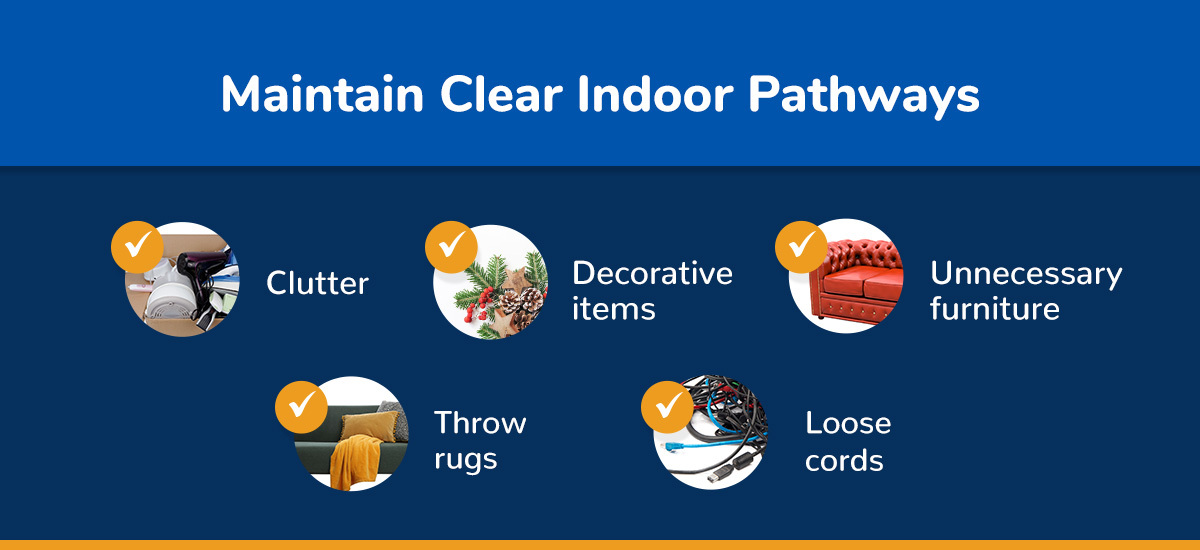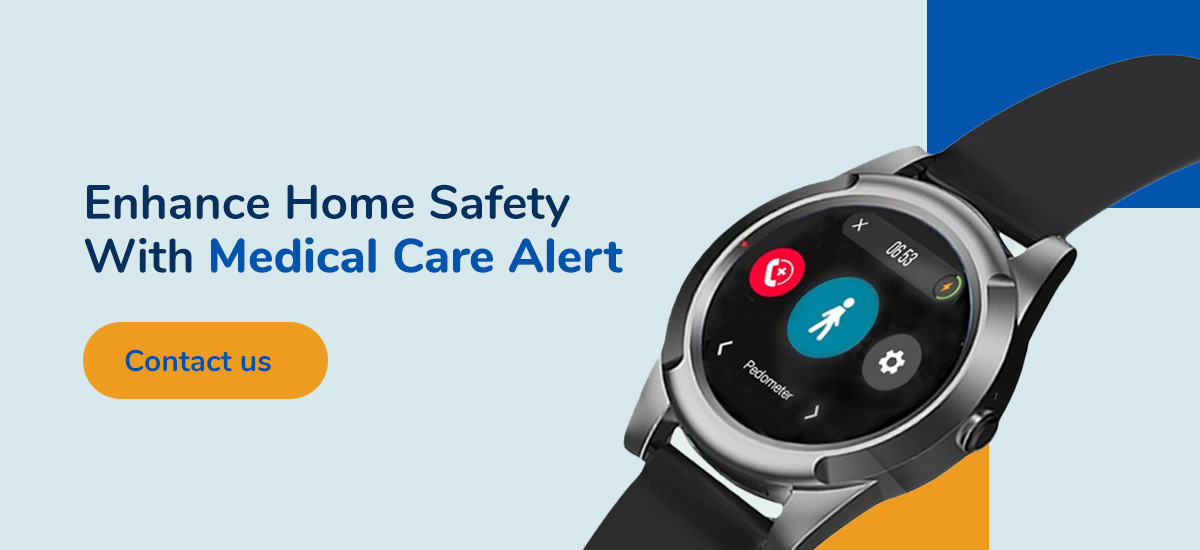Home Safety for Elderly Individuals
Feb 18th 2025
Senior home safety precautions and a Personal Emergency Response System (PERS) can help you or a loved one feel safer at home. The right safety measures can help prevent accidents and injuries, giving your family peace of mind. Use a home safety checklist for aging adults to go through the home and make helpful changes. Each adjustment helps you or your senior family member feel safer and more comfortable living independently.
How to Enhance Home Safety for Seniors
Older adults are more prone to falls, burns, poisoning, fires and electrocution. However, the right safety measures can help prevent these accidents. Use the following tips to make your home or a loved one's home safer:
Maintain Clear Indoor Pathways
Remove the following items from spaces to minimize tripping hazards:

- Clutter
- Decorative items
- Unnecessary furniture
- Throw rugs
- Loose cords
Clear Outdoor Pathways
Outdoor pathways should also be free of tripping hazards. Ensure driveways and sidewalks are level and free of debris and holes.
Reduce Slipping Hazards
Pay close attention to stairs and surfaces that could get wet. Nonslip stair treads provide more traction to help you or a loved one travel to different floors safely.
You can also mark the top and front edge of each stair with brightly colored paint tape and install handrails on both sides of the stairwell. Avoiding stair use is the safest option, but these precautions can help you minimize the chance of accidents if you need to use them. Another option is a stair lift seat if you or a loved one experiences challenges climbing up and down a staircase.
Grab bars in bathtubs, showers and around toilets can help seniors navigate bathrooms safely. Store toiletry items in easy-to-reach areas, and keep the floors dry for safer use.
Carpeting can also become a slip hazard. Remove or repair loose carpeting if it creates bumps, ripples or wrinkles on the floor.
Enhance Mobility
You can experience more independence and a higher quality of life when you can get around easier. Add helpful features such as a raised toilet seat and bathtub chair to make basic hygienic tasks easier.
Furniture such as the beds, couches and chairs should be easy to get in and out of. Ensure each piece of furniture is at the right height for easy access and minimal strain. Bed rails also enhance safety by preventing you or your loved one from rolling off the edge and helping you lift yourself from the bed each morning.
Walking aids are another essential part of home safety for older adults. If you or a loved one experiences unsteadiness or pain while walking, the following types of walking aids can help:
- Cane
- Quadripod cane
- Walker
- Knee walker
Organize Spaces
Organized spaces help you reach what you need without bending, straining or climbing. Place frequently used items in easy-to-reach areas. Ensure you or your loved one can access all items without needing to reach far or use a step stool. It's best if each item on shelves is easily visible and not hidden behind other items. Labeling storage spaces can help you stay organized and remember where to find everything. If you organize spaces for a senior family member, remember to ask them where they prefer to store each item.
Improve Lighting
Lighting is essential for preventing falls, slips and accidents. Ensure each room, hallway and staircase has adequate lighting. Regularly check lightbulbs and replace worn bulbs when necessary. You can also place nightlights in important areas such as hallways and bathrooms and install solar lighting along outdoor walkways.
Prevent Burns and Fire Hazards
Various appliances and accidents can cause burns or a fire. The following tips can make the home safer and less prone to burn risks:
- Use a microwave instead of a stove when possible.
- Replace smoke detector batteries at least once a year and carbon monoxide detector batteries every six months.
- Keep a fire extinguisher within easy reach.
- Set the water heater thermostat to 120 degrees Fahrenheit or lower to prevent water burns.
- Keep fire sources such as hot plates and candles away from flammable materials such as curtains.
- Replace fire sources like candles with flame-free items like wax warmers or scent diffusers.
Remove Harmful Chemicals From the Home
Mixing strong cleaning chemicals such as ammonia and bleach can be dangerous. Remove harsh chemicals from the home and replace them with gentler options such as vinegar, baking soda, castile soap and organic cleaning brands.
Install Ground Fault Circuit Interrupters
Ground fault circuit interrupters (GFCIs) turn power off when they detect ground faults. This helps prevent fires, burns and electrical shocks. Install GFCIs in areas such as the following where electricity could come into contact with water:
- Bathrooms
- Kitchens
- Garages
- Basements
- Exterior outlets
Practice Food Safety
Practice the following food safety tips to help prevent foodborne illness and choking:
- Throw food away if it passes its sell-by or use-by date.
- Store leftovers in the fridge and consume them within three to four days.
- Label leftover containers with the date you cooked them.
- Use separate cutting boards for produce and raw meat.
- Cut food into small pieces to prevent choking.
- Set timers to remind yourself to turn cooking appliances off after use.
- Avoid talking or laughing while eating.
Create an Emergency Contact List
Write a list of emergency contact numbers in clear, large print around the home for easy visibility. Include the following numbers you can call if you need immediate help:
- 911
- Poison control (1-800-222-1222)
- Healthcare provider's office
- Immediate family members or caregivers
Place a contact list in common areas such as the kitchen, living room and bedroom. Hanging lists on the fridge and bedside nightstands is an excellent option, but the key is to place them in easily accessible, memorable spots. If you or your loved one is familiar with cellphone use, you can also save emergency contact lists in the phone for easy access.
Create Emergency Plans
Emergency plans help prepare you in the event you need to evacuate your home. Create an emergency escape plan, review it and practice it to ensure it's free of mobility limitations. If you create an emergency escape plan for an elderly family member, go over it with them regularly so they remain familiar with it.
Use Medical Alert Systems for Emergency Response
Medical alert systems are wearable devices such as bracelets and necklaces you can use to request emergency assistance after a fall or accident. The following types of medical alert systems can detect falls and route to an emergency response center:
- GPS SmartWatches: A GPS SmartWatch features two-way communication, a pedometer and heart rate monitoring. It's water resistant and calls for emergency help as soon as it detects a fall.
- HOME & AWAY MINI cellular medical alert system: The HOME & AWAY MINI system is a pendant featuring GPS location, fall detection, two-way communication and check-in calls. Its three-day battery life, water resistance and voice setup make it a reliable and easy-to-use device.
- HOME system: Medical Care Alert's HOME System covers you or your loved one throughout your home. Each emergency response button is shower-safe and has a 1,000-foot range.
Home Safety Checklist for Seniors
Use the following senior safety checklist to ensure you check every part of the home:
Whole Home
Make sure each room in the house features the following:
- Medical alert system
- Clear walkways
- Sturdy handrails and nonslip rubber treads on stairways
- Clutter-free atmosphere
- Nightlights
- No rugs
- No loose cords
Bedrooms
Ensure each bedroom has the following:
- A bed that's easy to get in and out of
- Bed rails
- An easy-to-reach nightstand and lamp
Living Area
Check the living area for the following precautions:
- Sturdy, high furniture with rounded edges
- An emergency contact list in an easy-to-reach area
- No unnecessary furniture or decor
Kitchen
Ensure the kitchen has the following safety features:
- GFCIs
- An emergency contact list in an easy-to-reach area
- Timers
- A fire extinguisher
- Separate cutting boards for proteins and vegetables
- Food containers and labels
Bathrooms
Add the following safety features to the bathroom:
- GFCIs
- Nonslip bath mats and shower strips
- A toilet grab bar
- A raised toilet seat
- Shower grab bars
- A shower seat
Enhance Home Safety With Medical Care Alert
Enhancing safety around the home can help you or a loved one maintain independence for longer. Medical Care Alert is dedicated to enhancing home safety for elderly individuals through dependable medical alert systems and emergency response. Each system can detect falls and enables you to call for help if you need immediate medical assistance.
Our emergency response center knows who and where you are so we can respond quickly, and we keep a notification list on file to update your loved ones in the event of an emergency. Contact us to learn more about our medical alert systems.


